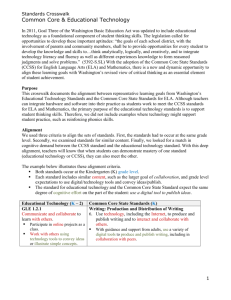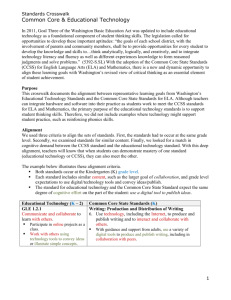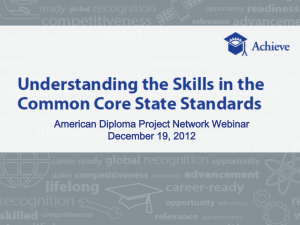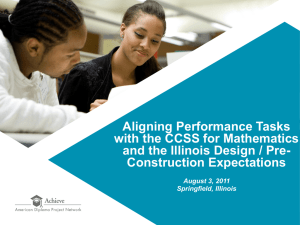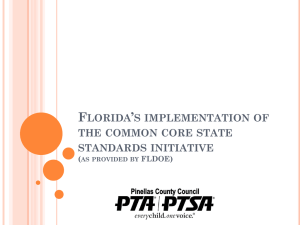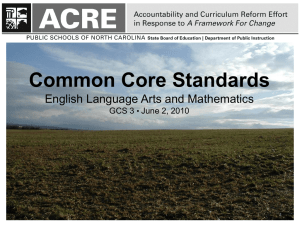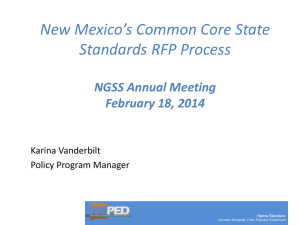California Crosswalk - California Community Colleges Chancellor`s
advertisement
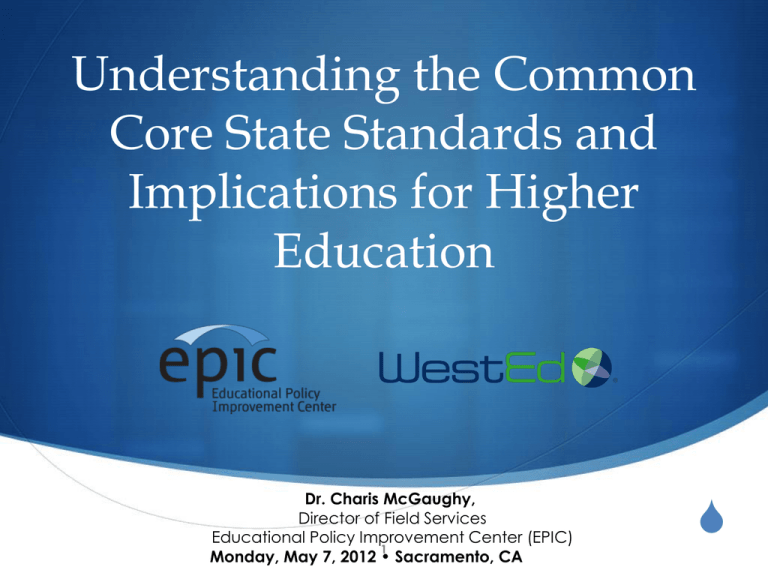
Understanding the Common Core State Standards and Implications for Higher Education Dr. Charis McGaughy, Director of Field Services Educational Policy Improvement Center (EPIC) 1 Monday, May 7, 2012 • Sacramento, CA S Objectives S Understand relationship between the Common Core State Standards and College and Career Readiness S Review EPIC’s findings from national Common Core studies S Describe WestEd/EPIC’s current Common Core studies in CA S Discuss implications for Higher Education 2 College and career readiness can be defined as success ‒without remediation‒ in credit-bearing general education courses or a twoyear certificate program. “Succeed” is defined as being able to progress successfully in the chosen program 3 S The Four Keys to College and Career Readiness think: Problem Formulation Research Interpretation Communication Precision & Accuracy go: Postsecondary Awareness Postsecondary Costs Matriculation Career Awareness Role and Identity Self-advocacy know: 1. Key Cognitive Strategies 2. Key Content Knowledge 4. Key Transition Knowledge and Skills 3. Key Learning Skills and Techniques Structure of Knowledge Technical Knowledge & Skills Challenge Level Value Attribution Effort act: Ownership of Learning Learning Techniques 4 Lining Up: The Relationship between the Common Core State Standards and Five Sets of Comparison Standards 5 S Research Questions ① To what extent are the knowledge and skills found in the comparison standards the same as or different from what is described in the Common Core State Standards? (match) ② What is the cognitive complexity level of the Common Core State Standards and to what extent are the matched comparison standards at a higher or lower level of cognitive complexity? (depth) ③ How broadly do the matched comparison standards cover the content of the Common Core State Standards? (breadth) 6 ELA DOK Overview Figure D3. California Standards Depth of Knowledge Levels Under, At, and Above, the Common Core for ELA and Literacy 0 25 50 75 100 Average Percent Reading for Literature Reading for Informational Texts Above Writing At Under Speaking and Listening Language Reading in History/ Social Studies Reading in Science and Technical Subjects Writing in History/Social Studies, Science, and Technical Subjects 7 Math DOK Overview Figure D6. California Standards Depth of Knowledge Levels Under, At, and Above, the Common Cor e for Mathematics 0 25 50 75 Number and Quantity 100 Average Percent % Above % At % Under Algebra Functions Geometry Statistics and Probability 8 Reaching the Goal: The Applicability and Importance of the Common Core State Standards to College and Career Readiness 9 S Research Questions ① How applicable are the Common Core standards to college courses? ② When they are perceived as applicable, how important are the Common Core standards to college courses? 1897 postsecondary instructors made two straightforward judgments on a per-standard basis All instructors were asked to rate all standards 10 Respondents by State 11 Overall Applicability S Overall applicability is high. S Variations exists among content areas and across different strands. S The Speaking and Listening and Language strands are rated applicable across essentially all subjects. S Nearly 96% of respondents said standards are sufficiently challenging cognitively. 12 Overall Importance S Importance rating of most ELA/L and many math standards exceeds 3 on a four-point scale. S The mathematics standards show a wider range of applicability and lower overall importance ratings. S Geometry category may be a candidate for further review. S The Standards for Mathematical Practices received the highest importance ratings from a very broad cross-section of respondents. 13 California Diploma Project Components S Crosswalk between ICAS and CCSS S Alignment between CTE Standards (Health) and CCSS S Validity study S Student focus groups 14 Part I: Crosswalk ICAS Statements of Competencies and Common Core State Standards I. Crosswalk S Exploratory study comparing ICAS Statements of Competencies and Common Core State Standards S December 2011 - March 2012 S Preliminary report and results drafted 15 Methodology Learning Expectations Analyzed About the Crosswalk S S A crosswalk is a means to examine relationships by arraying two sets of learning expectations orthogonally in a matrix format and then examining the intersection of each element of each statement in a unique cell. The relationship represented by that cell is then coded based on a categorization system designed to produce insight into how two sets of statements interact with one another. 16 S Intersegmental Committee of the Academic Senates (ICAS) Statements of Competencies for Mathematics and Academic Literacy. S Common Core State Standards (CCSS) in English Language Arts and Literacy (ELA) and mathematics. Crosswalk Codes A five point scale was used to rate each intersection on the crosswalk matrix. 17 ACR Aligned Content Relationship PACR Partially Aligned Content Relationship PCR Prerequisite Content Relationship CTLR Consistent Teaching/Learning Relationship ITLR Inconsistent Teaching/Learning Relationship Overall Findings Do all ICAS competencies relate to the CCSS? ELA Overall, yes, 92% of the time the ICAS are present in some way when the CCSS are taught or learned, except CCSS are missing certain “Habits of Mind” and English as a second language sufficiently Math Overall, yes, 98% of the time the ICAS are present in some way when the CCSS are taught or learned (except Subject Matter Desirable for all Students - Discrete Mathematics: set theory, graph theory, coding theory, voting systems, game theory, and decision theory. Three CCSS cluster level standards have no matches: • Functions: Model periodic phenomena with trigonometric functions • Geometry: Visualize relationships between two-dimensional and three-dimensional objects • Statistics and Probability: Interpret linear models 18 Part II and III: Alignment and Validity Health Sciences and Medical Technology CTE Standards II. Alignment III. Validity S Health Sciences and subject area experts analyze the relationship between the new draft Health Sciences Standards and the Common Core State Standards for: Content Alignment: Match, Partial Match (with rationales), and No Match will rate each of the Health Sciences standards for: Applicability: Prerequisite, Reviewed, Introduced, Subsequent, or Not Applicable Importance: 4-point scale from least to most S May 2012 - August 2012 Cognitive Complexity: 4-point scale of Depth of Knowledge S March 2012 – May 2012 S Faculty and industry experts 19 Preliminary Alignment Study Results The following slides outline the methodology and some preliminary results of the alignment between the Health Sciences Standards and the CCSS 20 S Methodology About the Alignment Methodology S Examines two dimensions of alignment: content alignment and cognitive complexity. S More rigorous methodology than crosswalk Research Questions S To what extent are the knowledge and skills found in the CA CTE Health Science Standards the same or different (aligned) to the Common Core State Standards? S What is the distribution of the cognitive complexity for both sets of standards across the four levels of a depth of knowledge scale? 21 Standards CA Common Core State Standards CA Health Sciences CTE Standards English Language Arts and Literacy (grade 11-12) • • • • Speaking and Listening Language Reading for Science and Technical Subjects Writing for History/Social Studies, Science, and Technical Subjects Mathematics (High School) • • • • • • • • Math Practices Number and Quantity Algebra Functions Geometry Statistics and Probability AP Probability and Statistics Calculus 22 • Biotechnology • Patient Care Pathway • Healthcare Administrative Services • Healthcare Operational Support Services • Public and Community Health • Mental and Behavioral Health Step 1: Depth of Knowledge Levels 1 2 3 4 23 Step 2: Alignment Relationship Codes Code Complete Alignment Partial Alignment No Alignment Rationale Statements for Partial Alignment Matches Definition All content in the Common Core State Standard(s) fully align with the Health Sciences Standard Some of the content in a standard from one set of standards relates to some or all of the content in another standard from the comparison set of standards. None of the content in the CCSS aligns with any of the content in the Health Sciences Standard Health Science Standard content is prerequisite to the CCSS CCSS content is prerequisite to the Health Science Standard Part of the Health Science Standard Matches All of the CCSS Part of the CCSS matches all of the Health Science Standard Part of the Health Science Standard matches part of the CCSS 24 Biotechnology Pathway Early Results The following slides outline the broad results of the relationship between the Biotechnology Pathway and the 1) ELA and Literacy Common Core State Standards, and 2) High School Mathematics Standards and Math Practices 25 S DOK Biotechnology Figure X. Percent of Common Core English Language Arts, Common Core Mathematics, and California Health Sciences Standards Rated at Each Depth of Knowledge Level 50% 48% 46% 45% 41% 40% 35% 31% 30% 26% 27% ELA and Literacy Mathematics 23% Health Sciences 20% 18% 18% Biotechnology 13% 10% 9% 7% 6% 5% 0% Recall Skill/Concept Strategic Thinking DOK Level 26 Extended Thinking Timeline 27 Implications for Higher Education S Adding SBAC as indicator of students’ readiness S S S S for entry-level, credit-bearing courses Aligning key policies: graduation, admission and placement requirements Aligning curricula and instructional materials S Secondary/postsecondary alignment S Adult/developmental/general education alignment Aligning teacher preparation and in-service teacher professional development Developing avenues at state and local levels for collaboration 28 28 For More Information Educational Policy Improvement Center 1-877-766-2279 Visit: www.epiconline.org Email: charis_mcgaughy@epiconline.org 29
